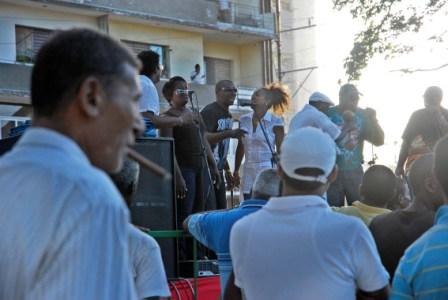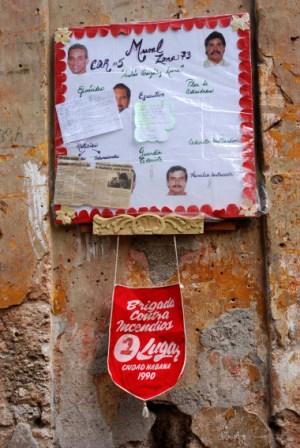Cuba’s Revolution Marks 50 Years
By RON RIDENOUR

HAVANA TIMES, January 1 – Modesty was the tone of Cuba’s celebration of its first half-century of revolution. The national act was held in Cespedes Park, in Santiago de Cuba, where Fidel spoke on January 1, 1959 after taking over the city.
Prior to the devastating hurricanes last fall, the government had planned a major celebration with visiting foreign presidents and military parades. Because of this natural setback plus the global economic crisis which has reduced the price of exports such as nickel and sugar, the government toned down its plans limiting its celebration to meet austere realities. No foreign leaders were present.
The downtown Cespedes Park is small and seated only 3,000 people. Almost all the invited guests were Cubans. The streets around the park were nearly deserted with the exception of a few civilian block guards and security personnel. There were no cheering crowds.

In the rest of Cuba, celebrations were limited to outdoor musical shows.
The commemoration in Santiago de Cuba was covered by about 120-150 foreign journalists transported by aircraft to the city and then in four buses from the airport. I did not see any organized international solidarity brigades or delegations as previously expected.
A documentary was shown on a dozen outdoor screens during the first hour of the one hour and forty-five minute ceremony. There were two dances, a few songs and poems honoring martyrs of the revolutionary struggle. Then President Raul Castro spoke for half-an-hour. He was briefly interrupted six times by modest applause.

“We have learned how to transform our dreams into a reality; how to keep our heads cool and our confidence in the face of dangers and threats; how to get over the big setbacks; how to turn every challenge into a victory and to overcome adversity,” the president told the gathering and a live nationwide TV audience.
However, Raul also referred to the famous speech that Fidel made to students on November 17, 2005. Fidel said, in essence, that the enemy cannot destroy the revolution but that Cubans can-because of lack of revolutionary morality and poor production-and it would be their fault.
Some delegates told me afterwards that they thought Raul was right because Cuba always lands on its feet and resists the worst of what the enemy launches at them.
Nonetheless, many Cubans are fleeing the land in order to improve their economic possibilities and others I have known from when I lived here for eight years do not share these delegates opinion. The double economy is a divisive factor, yet Raul chose not to delve into this theme.
The only time in which Raul spoke of internal problems was in reference to persons who choose not to work but to hustle as parasites, seeking the easy life. He quickly mentioned that criticism was useful but warned against division, which he said leads to defeat.
Raul sketched the history of US subversion, direct and indirect, violent and economic against Cuba. He noted that the US government and its Cuban exile terrorists have murdered 3,478 Cubans and handicapped 2,099. “Liberty has a high price,” he concluded.
On three occasions, the President referred to Fidel and his historic role. These were the points of greatest applause.
For a veteran following the Cuban revolution for half-a-century, I was disappointed at the austerity of its official celebration.






…”many Cubans are fleeing the land in order to improve their economic possibilities…” It will be interesting to see how they will fare in Florida or New York. The U.S.A. is loosing 14,000 jobs each and every day. Not only retail, sales and food service, but also agricultural and construction, even the IT sector. The “official” unemployment rate is around 7%, but if truth be told, when all the “discouraged workers” are added in, this more than doubles the rate, and the rate for adolescents is truly approaching the level of the Great Depression. The housing market continues its steep decline. The next crisis will be the massive default of credit card payments. The results of stimulation in employment by the massive public works infrastructure projects proffered by Obama will not begin to be felt ’til much later this year, or early next. In my neck of the woods, which isn’t even near such epicenters of crisis as Boston, South Florida, Las Vegas, San Francisco, L.A. and surroundings, we already see the multiplaction of empty storefronts, the closing of numerous restaurants (one of which was a fixture, here for 80+ years), even the closing of several “big box” stores, such as Home Depot, J.C. Penny, etc. I suspect that there will be a ripple effect in Cuba, especially with the tourist industry, as I don’t see as many people (from Canada, from Europe) taking vacations if they are worried about their jobs or, worse yet, are actually laid off. On the other hand, the embargo makes even less sense now, since farmers could sell their food to Cuba. Also, since the “Big Three” auto makers are offering their models now to folks with low credit scores, why couldn’t they sell, on such credit, to Cuba, thus finally replacing all those dinosaurs from the 1950’s??!! (Although I’m never going to be suckered into buying an American car again…my Toyotas have all lasted well over 200,000 miles–in one case well over 350,000 miles– while my wife’s Fords are ready for the bone-yard at half that milage!)
I suspect that any of the Cubans heading North will really have to have some hustle and ingenuity to find suitable employment (enough upon which to live comfortably and, what is more important, send $$$ home). Maybe they should be heading to (je, je, je), CHINA instead!